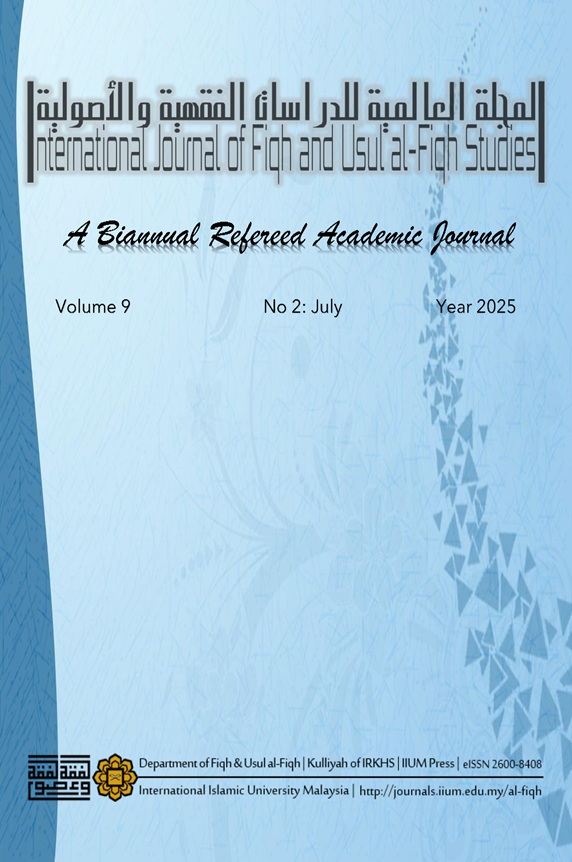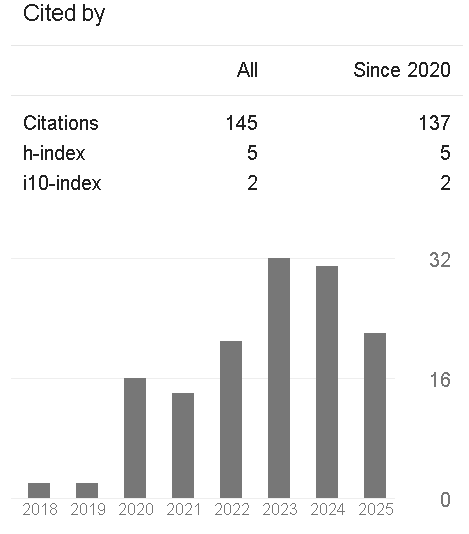The Jurisprudence of the Prohibition and Permission of Coffee and its Social Phenomenon
DOI:
https://doi.org/10.31436/ijfus.v9i2.371Keywords:
Jurisprudence of permissibility and prohibition, Coffee, Coffeehouses, Social Phenomenon, Community jurisprudenceAbstract
The history of coffee consumption and the spread of coffee beans were the target of many studies. However, few of them addressed the phenomenon as an integrated social phenomenon. At the beginning of the sixteenth century, coffee entered the corridors of jurists and was the subject of great controversy regarding prohibition and permissibility. Nonetheless, there are only a few studies on how jurists dealt with this new beverage and the social phenomenon that arose from it. This paper employs the inductive method in tracing the early history of coffee to analyse its elements. Furthermore, it uses the analytical method to understand how it transformed from a special drink of certain Sufi sects, initially popularized as an intoxicant, to an elite drink and then a social drink that spread among all segments of society before becoming a social phenomenon. The paper also takes into account the historical approach in tracing attempts to ban coffee or close its establishments from the beginning of the 16th century onwards in Makkah, Cairo, and the rest of the Islamic world, and the beginnings of jurists' engagement with coffee as a beverage and a social phenomenon until the end of the 18th century. The paper continues by comparing the jurisprudential reasons used by jurists in determining its legal ruling, as well as the social phenomena associated with it over three centuries. The paper concludes with the flexibility and diversity of legislative tools used by scholars, including the experimental approach and what some call it as "community jurisprudence" in the present time, and the relationship of this to the place and time in which it occurred. The work concluded that coffee took more than two centuries to evolve into a multifaceted social phenomenon that varied in time, place, and customs. During this period, numerous fatwas were issued, prohibiting or permitting it. The jurisprudential causes for prohibition varied between prohibited in itself, for others, or as a blocking means (dharāʾiʿ-pretexts). The paper also denies that the old meaning of the word coffee, “wine,” has anything to do with the naming of the new beverage made from coffee beans, nor does it have anything to do with the reasons of prohibition.
Downloads
Metrics
References
Abdul Karim, R. (2001). The Socioeconomic and Political Implications of the Introduction of Coffee into Syria. 16th – 18th Centuries. In M. Tuchscherer (Ed.), Le Commerce du café : Avant l’ère des plantations coloniales espaces, réseaux, sociétés (XVe-XIXe siècle). IFAO.
al-‘Aydarus, Abu Bakr Abu al-Hassan Muhammed. (1524). Iṣṭifā’ aṣ-Ṣafwa li-Taṣfiyat al-Qahwa Or. 1138 (Universiteit Leiden). Digital collections. http://hdl.handle.net/1887.1/item:292051
al-Anṭākī, D. ibn ʻUmar. (1996). Tadhkirat Dāwūd al-musammá Tadhkirat ūlá al-albāb wa-al-jāmiʻ lil-ʻajab al-ʻujāb (1st ed.). Dār al-Fikr.
al-Arnāʼūt, M. M. (2012). Min al-tārīkh al-thaqāfī lil-qahwah wa-al-maqāh. Jadāwil lil-Nashr wa-al-Tawzīʻ.
al-ʻAydarūsī, Muḥyī al-Dīn ʻAbd al-Qādir. (1985). Tarikh al-Nūr al-sāfir ʻan akhbār al-qarn al-ʻāshir. Dār al-Kutub al-ʻIlmiyah.
al-Barkatī, M. ʻAmīm al-Iḥsān al-Mujaddidī. (1986). Qawāʻid al-fiqh. https://platform.almanhal.com/MNHL/Preview/?ID=1-12236
al-Bukhārī, A. ʿAbd A. M. ibn I. ibn I. al-Juʿfī. (2002). Ṣaḥīḥ al-Bukhārī (M. zuhir al-Nasir, Ed.). dar al-Minhaj.
al-Burayhī, ʻAbd al-Wahhāb ibn ʻAbd al-Raḥmān al-Saksakī al-Yamanī. (1994). Ṭabaqāt ṣulaḥāʼ al-Yaman al-maʻrūf bi-Tārīkh al-Burayhī (ʻAbd Allāh Muḥammad al-Ḥabashī, Ed.; 2nd ed., Vols. 1–2). Maktabat al-Irshād.
al-Ghazzī, N. al-D. M. ibn M. (1997). Al-Kawākib al-sāʼirah bi-aʻyān al-miʼah al-ʻāshirah. Dar al-Kutub al-ʿİlmiyye.
Ali Haydar Efendi. (2003). Dürerü’l-Hükkâm Şerhü Mecelletü’l-Ahkâm. Dâru’l-Cîl.
al-Jazīrī, ʻAbd al-Qādir ibn Muḥammad. (1996). ʻumdat al-ṣafwah fī ḥill al-qahwah (ʻAbd Allāh Muḥammad al-Ḥibshī, Ed.). Hayʼat Abū Ẓaby lil-Thaqāfah wa-al-Turāth, al-Majmaʻ al-Thaqāfī.La Roque, J. de (1661-1745) A. du texte. (1716). Voyage de l’Arabie heureuse, par l’océan oriental, & le détroit de la mer Rouge. https://gallica.bnf.fr/ark:/12148/bpt6k1520744h
al-Luhaidan, Fahd ibn Saleh. (2021). Food Rules extracted from animal waste (coffee extracted from animal dung or vomit as a model) jurisprudence study. Al-Azhar University (Dakahlia Branch), Faculty of Sharia and Law, 23(6), 1663–1688. https://doi.org/10.21608/jfslt.2021.217883
al-Mūsawī, ʻAbbās ibn ʻAlī ibn Nūr al-Dīn al-Ḥusaynī. (1967). Nuzhat al-jalīs wa-munyat al-adīb al-anīs (Muḥammad Mahdī al-Khurasān, Ed). al-Maṭbaʻah al-Ḥaydarīyah.
al-Quraishi, T. A. al-K. K. (2012). Social phenomenon when Emile Durkheim (social analysis). Contemporary Islamic Studies Magazine, 6, 1–15.
al-Ramlī, S. al-D. M. ibn A. al-ʻAbbās A. ibn Ḥamzah S. al-Dīn. (n.d.). Fatāwá al-Ramlī (Vols. 1–4). al-Maktabah al-islamiyya.
Al-Saifi, Abed Alluh Ali, & Emran, Abdel Arhman Haj. (2021, November 1). Islamic Position on Drinking Luwak Coffee. | EBSCOhost. https://openurl.ebsco.com/contentitem/gcd:154130888?sid=ebsco:plink:crawler&id=ebsco:gcd:154130888
al-Sharjī, A. al-ʻAbbās A. ibn A. ibn ʻAbd al-Laṭīf. (1986). Ṭabaqāt al-khawāṣṣ ahl al-ṣidq wa-al-ikhlāṣ. al-Daru al-Yemaniyya lîl Neşru wa Tauzıʻ.
al-Zabīdī, M. (1758). Tuḥfat ikhwản az-zaman fī ḥūkm al-qahwat (5595). https://makhtota.ksu.edu.sa/makhtota/6007/1
Alzaeem, İ. (2021). Al-Quds Cafés and Their National Role from the End of the Ottoman Era Until the Israeli Occupation. Journal, 21(1), 151–162.
al-Zuḥaylī, W. (1997). al-Fiqh al-Islāmī wa-adillatuh: Al-shāmil lil-adillah al-sharʻīyah wa-al-ārāʼ al-madhhabīyah wa-ahamm al-naẓarīyāt al-fiqhīyah wa-taḥqīq al-aḥādīth al-Nabawīyah wa-takhrījihā mulḥaqqan bi-hi fahrasah alfabāʼīyah shāmilah lil-āyāt wa-al-ahādīth wa-al-mawḍūʻāt al-fiqhīyah (4th ed.). Dār al-Fikr.
Arendonk, van. Chaudhuri, & Brill. (2012). Ḳahwa. In Encyclopaedia of Islam, Second Edition. https://doi.org/10.1163/1573-3912_islam_COM_0418
Ayvazoğlu, B. (2011). Turkish coffee culture: “a cup of coffee commits one to forty years of friendship” (1st ed). Republic of Turkey, Ministry of Culture and Tourism Publications.
Ba' Amer, M. selem B. (2014). Al Hissba Practice in Makkah during the Memlouk Sultans Era. Journal of Arabic and Human Sciences, 7(Issue 2), 807–882.
Collaço, G. (2011). “The Ottoman Coffeehouse: All the Charms and Dangers of Commonality in the 16th-17th Centuries,” Lights: The MESSA Journal, A University of Chicago Graduate Publication 1, No. 1 (Fall 2011): 61-71.
Evliya Celebi. (1999). Al Rihla al Hijaziyya (el-Sıfsafi Ahmed el-Morsi, Trans.). Dar al-Afaq. https://library.dctabudhabi.ae/sirsi/detail/118151
Evliya Celebi. (2010). Al-Rihla ’ila Misr wa-al-Sudan wa-bilad al-Habash (el-Sıfsafi، Ahmed el-Morsi, Trans.; Vols. 1–3). el-Merkez al-Qawmi li-tarjama.
Hanna Nelly. 2001. Coffee and coffee merchants in Cairo, 1580-1630. In : Le commerce du café avant l'ère des plantations coloniales : espaces, réseaux, sociétés (XVe-XIXe siècle). Tuchscherer Michel (ed.) Cairo : IFAO, 91-101.
Hatim, M., & Hayim, N. (2018). al-Qahwa mā bayna al-Tahrīm wa-al-ibāha: Al-Jadal al-Dīnī fī avākhir al-‘Asr al-‘Uthmānī. Al-Majma‘, 13, 35–78
Hattox, Ralph. (1988). Coffee and coffeehouses: The origins of a social beverage in the medieval Near East. Seattle: University of Washington Press.
Ibn Abd al-Ghaffar. (996). Risalet Dafa al-Hafwa fi hill al-Qahwa (Aref Hikmat Library) [Fiqh]123/54. https://dar.kawla.gov.sa/en/node/3652
Ibn al-ʻImād, ʻAbd al-Ḥayy ibn Aḥmad. 1623-1679. (1986). Shadharāt al-dhahab fī akhbār man dhahab. Dār al-Kutub al-Ilmīyah
Ibn al-Qa’id, li-ʻUthmān ibn A. ibn S. al-Najdī. (2021). Hidāyat al-rāghib li-sharḥ ʻUmdat al-ṭālib li-nayl al-maʼārib (abd al-aziz al-Aydan & A. al-Yatimi, Eds.; Dar Rakaez).
Ibn el-Kasım, Y. b el-Hūseyin. (1986). El-Mustaḫracātu el-baynātu ʿAla tahlīl el-ʾaşyā’ el-Mustaʿmalāt min el-Kahve ve el-Āṭbāk ve el-Kāṭ (A. b. M. Ḥibšī, Ed.; 1st ed.). Menşūrātu el-Madine.
Ibn Ḥajar al-Haytamī, S. al-D. A. ibn M. ibn M. (1949). Al-Fatāwá al-kubrá al-fiqhīyah ʻalá madhhab al-imām al-Shāfiʻī (Vol. 1–IV). Mektebetu’l-İslāmiyye.
Ibn Manzūr, Ebū’l-Fazl Muhammed b Mūkerrem b Ali el-Ensārī. (2023). Lisānū’l-Arab (3rd ed., Vol. 1). Dāru Sadır.
Ibn Taymīyah, li-A. ibn ʻAbd al-Ḥalīm ibn ʻAbd al-Salām. (2019). Jāmiʻ al-masāʼil /; taḥqīq Muḥammad ʻUzayr Shams; ishrāf Bakr ibn ʻAbd Allāh Abū Zayd, Aḥmad ibn ʻAbd al-Ḥalīm Ibn Taymīyah, (Muḥammad ʻUzayr Sham, Bakr ibn ʻAbd Allāh, & Abū Zayd, Eds.). Dar Ata’at elim.
Ibrahim, N. A. (2014). "adab wa ṭuqus shurb al-qahwe fi al-qahira al-ʾüsmaniati”. Annales Islamologiques, 48(2), 217–247. https://doi.org/10.4000/anisl.2019
Islamweb.net, Ruling on drinking coffee extracted from animal waste. Retrieved Avril 30, 2025, from https://isla.mw/ae2qik
Mantran, R. (1980). Le café à Istanbul au xviie siècle. In Boulanger, J. Contandriopoulos, M. Courdurie, H. Desmet-Gregoire, Fabre, J.-L. Miege, L. Pierrein, & A. Raymond, Le café en Méditerranée : Histoire, anthropologie, économie. XVIIIe-XXe siècle ( 17–30). Institut de recherches et d’études sur les mondes arabes et musulmans. https://doi.org/10.4000/books.iremam.1193
Marino, B. (2013). Le faubourg du Mīdān à Damas à l’époque Ottomane: Espace urbain, société et habitat (1742-1830) (Vol. 1–1 online resource (431 pages) : illustrations.). Presses de l’Ifpo.
Māzāk, B. (2023). Al-Istidlāl bi-al-Qiyās fī ba‘d al-Masāil al-Mu‘āsira. Majalla al-Mirqā li-al-dirāsāt wa-al-buhûth al-Islāmiyya, 9, 162–186.
Milstein, R. (2001). Kitab Shawq-nama—An illustrated tour of holy Arabia. Milstein, R. (2001). Kitab Shawq-Nama - an Illustrated Tour of Holy Arabia. 25, 275., 25.
Mosalhy, A. F. (2022). Jāmi ’al-masāʼil wa al-qawā’id f ʻilm al-uṣū lwa al-maqāṣid (Vols. 1–4). Dār al-Luʼluʼah lil-Nashr wa-al-Tawzīʻ.
Mouradgea d’Ohsson, I. (1788). Tableau général de l’Empire Othoman: Divisé en deux parties, dont l’une comprend la législation mahométane, l’autre, l’histoire de l’Empire Othoman ... De l’imprimerie de monsieur [Firmin Didot].
Muqasher, A.-W. K. H. (2018). The emergence of Arabic coffee and the spread of coffee cultivation in Yemen Between the fourteenth and seventeenth centuries AD. Research magazine, (6) 2016, 245–290.
Murādī, M. K. ibn ʻAlī, -1791 or 1792. (1966). Kitab silk al-durar fi a’yan al-qarn al-thani ’ashar. Dar al-Tiba’ah al- Kubra al-’Amirah.
Muṣayliḥī, ʻAbd al-Fattāḥ Muḥammad. (2022). Jāmiʻ al-Masa’il wa al qawa’id fi ilum al-Usul wa al-Maqasid. Dār al-Luʼluʼah lil-Nashr wa-al-Tawzīʻ.
Özen, Şükrü. (2005). Sağlık Konularında Dinî Hükmün Belirlenmesinde Fakih-Tabip Dayanışması: Kahve Örneği. 38 Uluslararası Tıp Tarihi Kongresi Bildiri Kitabı (699-736), Ankara: Türk Tarih Kurumu Yayınları.
Peçevī, İ. (2015). al-Tārīkh al-siyāsī wa-al-ʻaskarī lil-dawlah al-ʻUthmānīyah: Tārīkh Bijawī Ibrāhīm Afandī (Ḥusayn Nāṣir ʻAbd al- Raḥīm, Trans.; 1st ed.). Merkez al-qawmī lil-tarjamah; Mashrūʻ al-qawmī lil-tarjamah.
Sakhāwī, M. ibn ʻAbd al-Raḥmān. (2003). Al-Ḍawʼ al-lāmiʻ li-ahl al-qarn al-tāsiʻ (ʻAbd-al-Laṭīf Ḥasan ʻAbd-al-Raḥmān, Ed.; Vols. 1–12). Dāru’l-Kütübi’l-’Ilmiyye.
Saraçgil, A. (1997). Chapitre premier—L’introduction du café à Istanbul (XVIe-XVIIe siècles). In Cafés d’Orient revisités (25–38). CNRS Éditions ; Cairn.info. https://doi.org/10.3917/cnrs.desme.1997.01.0025
Sarīḥī, S. M. (2011). Ghawāyat al-ism: Sīrat al-qahwah wa-khiṭāb al-taḥrīm (1st ed.). al-Nādī al-Adabī bi-al-Riyāḍ ; al-Markaz al-Thaqāfī al-ʻArabī.
Suleiman, H., Abdullahi Busari, S., & Musa, U. A. (2023). Maʾālāt (Consequences) and Their Uṣūlī Maxims: A Juristic Applied Study, 7(2), 34–44. https://doi.org/10.31436/ijfus.v7i2.301
Ukers, W. H. (1922). All about coffee (2d ed). The Tea & Coffee Trade Journal Company New York.
Ulusoy, T. (n.d.). Kahvehane ve Kahve Tüketiminin Cinsiyetlendirilmesi. Retrieved 31 December 2023, from https://www.academia.edu/2475584/Kahvehane_ve_Kahve_T%C3%BCketiminin_Cinsiyetlendirilmesi
Yaşar, A. (2010). Osmanlı’da Kamu Mekānı Üzerinde Mücadele: Kahvehane Yasaklamaları. 4–2.
Zilfi, M. C. (1986). The Kadizadelis: Discordant Revivalism in Seventeenth-Century Istanbul. Journal of Near Eastern Studies, 45(4), 251–269
Downloads
Published
How to Cite
Issue
Section
License
Copyright (c) 2025 International Journal of Fiqh and Usul al-Fiqh Studies

This work is licensed under a Creative Commons Attribution-NonCommercial 4.0 International License.
The IIUM journal follows the open access policy.
Consent to publish: The Author(s) agree to publish their articles with IIUM Press.
Declaration: The Author(s) declare that the article has not been published before in any form and that it is not concurrently submitted to another publication, and also that it does not infringe on anyone’s copyright. The Author(s) holds the IIUM Press and Editors of the journal harmless against all copyright claims.
Transfer of copyright: The Author(s) hereby agree to transfer the copyright of the article to IIUM Press, which shall have the exclusive and unlimited right to publish the article in any form, including in electronic media. However, the Author(s) will reserve the right to reproduce the article for educational and scientific purposes provided that the written consent of the Publisher is obtained. For the article with more than one author, the corresponding author confirms that he/she is authorized by his/her co-author(s) to grant this transfer of copyright.





















